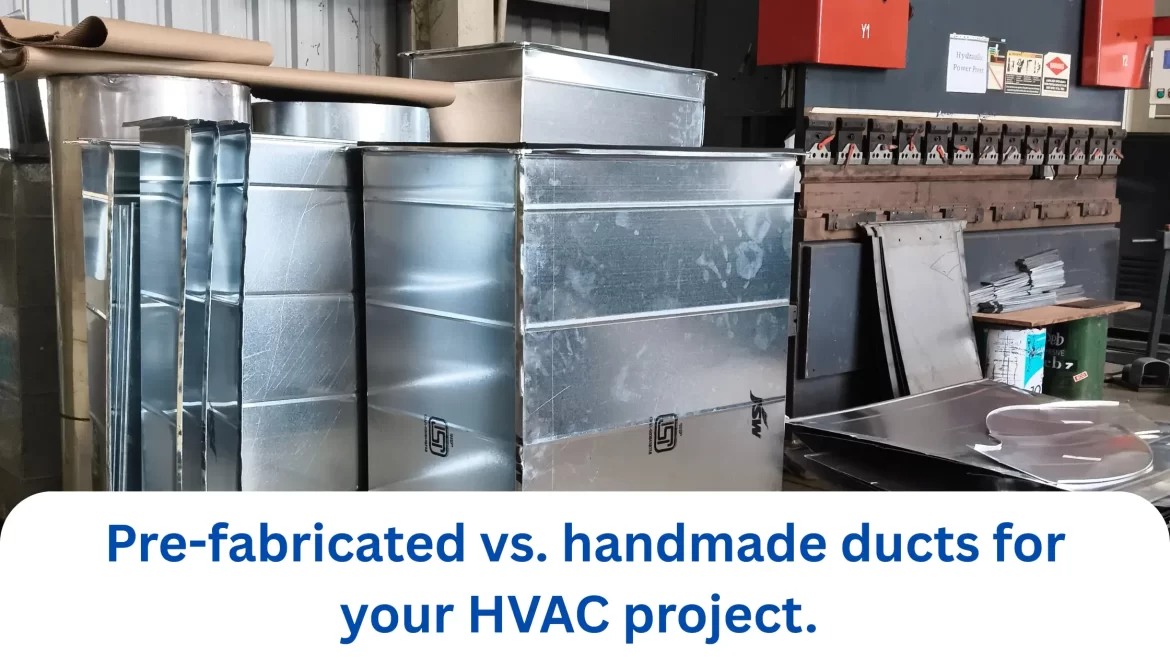When planning an HVAC system, choosing the right type of ductwork is a decision that can significantly impact performance, energy efficiency, and installation time. The debate often boils down to prefabricated ducts versus handmade ducts. Both options serve the purpose of air distribution effectively, but they differ in precision, cost, installation speed, and long-term performance. Let’s explore these differences so you can make an informed choice for your project.
What Are Prefabricated Ducts?
Prefabricated ducts are manufactured in a factory using advanced machinery and automated processes. Each duct is cut to precise dimensions, often pre-insulated, and tested for quality and air-tightness before reaching the site.
Key Features of Prefabricated Ducts:
– Factory precision and standardization: Every piece is manufactured to exact specifications.
– Faster installation on site: Pre-cut and ready for assembly, reducing on-site labor.
– Pre-tested for quality and leakage control: Ensures consistent airflow and energy efficiency.
– Reduced on-site labor and errors: Factory production minimizes mistakes common in manual fabrication.
Why Choose Degree Day?
As Central India’s largest prefabricated duct manufacturer, Degree Day Pvt. Ltd. provides high-quality ducts with unmatched precision and durability. With pan-India delivery across Uttar Pradesh, Maharashtra, Gujarat, Madhya Pradesh, and Chhattisgarh, your HVAC projects can enjoy reliable support and timely logistics.
What Are Handmade Ducts?
Handmade ducts are fabricated manually on-site or in small workshops. Skilled technicians cut, bend, and assemble sheet metal, usually galvanized steel or aluminum, according to project requirements.
Key Features of Handmade Ducts:
– Highly flexible in design and fit: Ideal for complex layouts or irregular spaces.
– Adaptable for last-minute changes: Modifications can be made directly on site.
– Labor-intensive and skill-dependent: Workmanship quality directly impacts performance.
– More prone to leakage and errors: Manual assembly can lead to inefficiencies if not closely supervised.
Sustainability and Energy Efficiency
Energy efficiency is a crucial factor in HVAC performance. Prefabricated ducts typically offer superior air-tightness, reducing energy loss and ensuring optimal system efficiency. In contrast, handmade ducts, if not sealed perfectly, can waste up to 30% of conditioned air, driving up operational costs over time.
Prefabricated vs. Handmade Ducts: Pros and Cons
| Feature | Prefabricated Ducts | Handmade Ducts |
| Installation Speed | Fast | Slower |
| Air Leakage | Low | High (depends on workmanship) |
| Design Flexibility | Limited | High |
| Energy Efficiency | Excellent | Variable |
| Cost | Higher upfront | Lower upfront |
| Maintenance | Lower | Potentially higher |
Which Should You Choose?
Go for Prefabricated Ducts If:
– Your project is large-scale: commercial, industrial, or institutional.
– You want fast installation, lower leakage, and long-term efficiency.
– Your goal is green building certification or compliance with energy-efficient standards.
– You prefer a trusted manufacturer with pan-India delivery, like Degree Day.
Choose Handmade Ducts If:
– Your project has space constraints or unusual layouts.
– You need quick modifications during construction.
– Upfront budget constraints are more important than long-term efficiency.
Both prefabricated and handmade ducts have their place in HVAC projects. If your priority is quality, speed, and energy efficiency, prefabricated ducts from a trusted manufacturer like Degree Day are the smarter choice. For projects requiring custom shapes, tight spaces, or last-minute adjustments, handmade ducts still serve an important role.
Related Articles
- Importance of Proper Ventilation in Commercial Kitchens
- Why Desert Coolers Fail in Big Spaces and How Central Air Cooling Solves This
- How PM2.5 and PM10 Impact Your Lungs
- Top 3 Commercial & Industrial Coolers
- Which HVAC System Suits Your Industry? A Complete Guide for Every Sector
Prefabricated ducts usually have a higher upfront cost due to factory production, but offer long-term savings through energy efficiency and reduced maintenance.
It’s possible, but achieving the required air-tightness and efficiency requires highly skilled labor and quality supervision.
With proper installation, prefabricated ducts can last decades while maintaining consistent performance.

